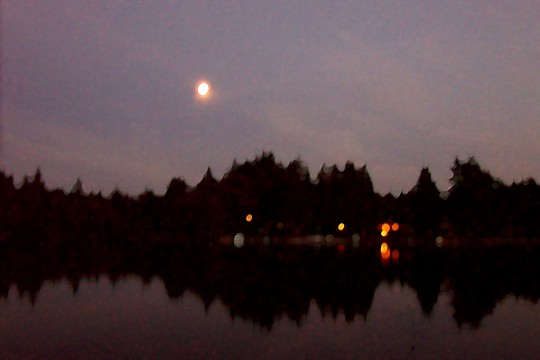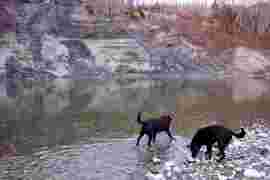Life at the Lake
a diary of living at a small lowland lakeWHAT IT'S LIKE

Early moonrise over Lake Ketchum
|
Archive Search |
| Links |
|
and s-integrator |
MORE LANDSLIDE
272
Picture is of the toe of the Steelhead Haven Slide, looking Southwest, with wife and dogs in the foreground. This is the newest part of the slide, which is unraveling from its head, year after year. Soon there will be no more place for it to go on the downstream side and the river will change channel, accordingly. It will probably swing to the bar side a bit, then cut a new path at an acute angle and head downstream to the North.
This is only a guess. Rivers go wherever they wish and are successfully resisted only with riprap. If they don't like the riprap, they will try to skirt it, run around it, and form a new channel behind it. Again, only a guess.
There are plans afoot to build some upstream wooden debris revetments to veer the river away from the face of the slide, but years pass and the funding isn't found, and the river continues to erode the clay and sand of the face of the cliff. It is nearly vertical, which is a bad sign, for the sloughing will continue at an enhanced speed.
Someday the river will cut through the face to the North and reach bedrock, which will halt the slide's progress, but that is about a mile away, and will probably take a decade or two. Meanwhile the river is rapidly losing its anadromous fish population (steelhead and five species of Pacific salmon). To date hatcheries have not helped, and the loss looms permanent.
- - Comments ()
...
RIVER LANDSLIDE

Another picture of the humungous landslide that threatens an important river
271
Another picture of the slide at Steelhead Haven, from a slightly different angle. There is not a wide-angled lens capable of reproducing the length of the slide, without making it appear tiny and insignificant.
It was a long time in coming about, starting as a small, gray claybank that would slough slightly into the river after a hard rain and turn the river gray. Fishers, however, caught steelhead on bright flies designed to be seen is just such water. So we all became accustomed to the unattractive color, and so did the fish. But logging off in the hills took a gradual toll of snow and rainwater runoff, which, rather than be gradual, became excessive over a short period of time, and the river began to flood. One such flood back in the mid-Sixties caused the river to change its channel drastically and cut into a small settlement of mostly summer cabins, isolating them from their access road. And in the process the slide worsened noticeably.
Once begun in earnest the slide area became steadily gnawed at by the normal behavior of the river, and cut to the North, where the terrain lacked bedrock and consisted mainly of stratifications of sand and pernicious clay. (The picture above illustrates this pretty well.)
Annually, during the winter, the slide worsened from perhaps fifty feet in length to hundreds of feet. Above it stood forestland owned by the big lumber mill in Darrington, Summit. The area to the North stood second-growth ready for harvest, and plans were made to cut timber right down to the uppermost steep edge.
Certain environmentalists, including myself, protested this proposed action, and the Washington Environmental Council took the case to court and won and alteration in the cutting line. It moved back, that is, further to the North, but the landside was so steep that it was a minor change, and the timber harvest went on.
It would be inaccurate to say that the logging caused the slide to worsen and expand its length, I think. But it did not help the situation. Perhaps nothing would. In the years afterwards the length of the slide doubled.
Today the river—a famous steelhead flyfishing stream—is virtually unfishable for most of the year. In the long-run scheme of things this is probably minor. We have lost our luxury sport, and the wild winter steelhead are disappearing at an alarming rate over the past half-dozen years.
More important is the fact that the Summer Chinook—long abetted by a hatchery program conducted by the Stillaguamish Tribe—is unable to bring the salmon run back to harvestable size. It appears that it may be permanently lost. This is an important cultural loss to the tribe that identifies itself as "river fishers," which makes it quite different from other tribes, such as the much larger and affluent Tulalips, who fish primarily in saltwater.
So my friends and I, fishers, and our piscatorial companions, the Stillys, have lost an important and meaningful resource. The slide at Steelhead Haven is not the sole cause, but it is an important contributor to the loss, and in spite of a plan to mitigate the slide it appears at the present time that the loss is irremediable.
- - Comments ()
...
LANDSLIDE

Part of the Steelhead Haven slide on the North Fork of the Stillaguamish River, in Washington State. (Dogs shown for perspective.) The length of the slide is about a third of of a mile and the picture above represents about 15f its length.
270
On Friday Norma and I hiked in to the humongous slide just above our river property. We'd heard it had worsened at its downstream end and we quickly saw that it had; the reports had not been exaggerated at all.
We picked a good day for it, for the river was low and not a lot of blue clay was pouring into it. Still, along the far bank, the river was picking up a steady cast of gray; slowly it widened and changed the river's color from emerald green.
Historically a respectable run of Summer Chinook salmon used to spawn in this reach, and for miles above and downstream, say, for another 20 miles. But now, in spite of an egg- taking hatchery program from what is left of the brood stock by the Stillaguamish Indians, the river is not reproducing itself and only a few hundred adults return each year to spawn.
Observed turning over the gravels with their broad tails, the river silt (mostly from this slide) quickly descends and covers the nest, effective sealing it from the life-giving oxygen the eggs need to mature and hatch.
But this is only one of the key reasons these fish are endangered.
Others include loss of rearing habit and unknown amounts of predation of fry and smolts as they mosey downriver and out to sea.
And then they simply disappear, not to be seen again, except perhaps in driftnets far out at sea.
- - Comments ()
...